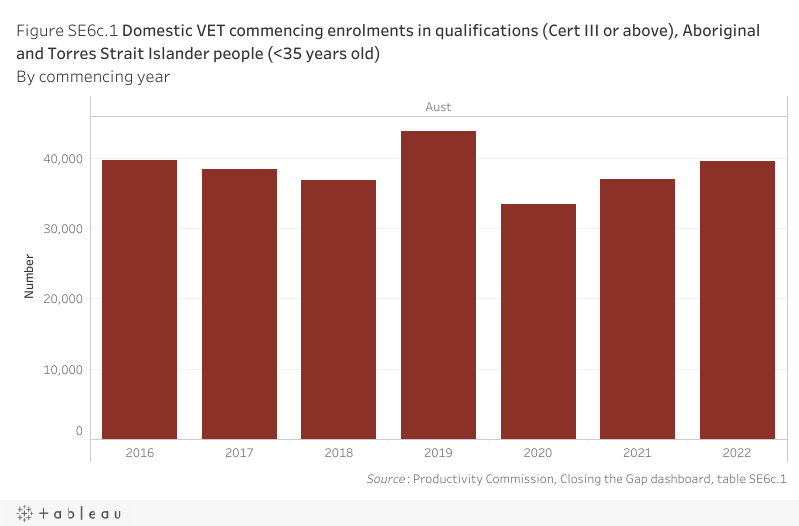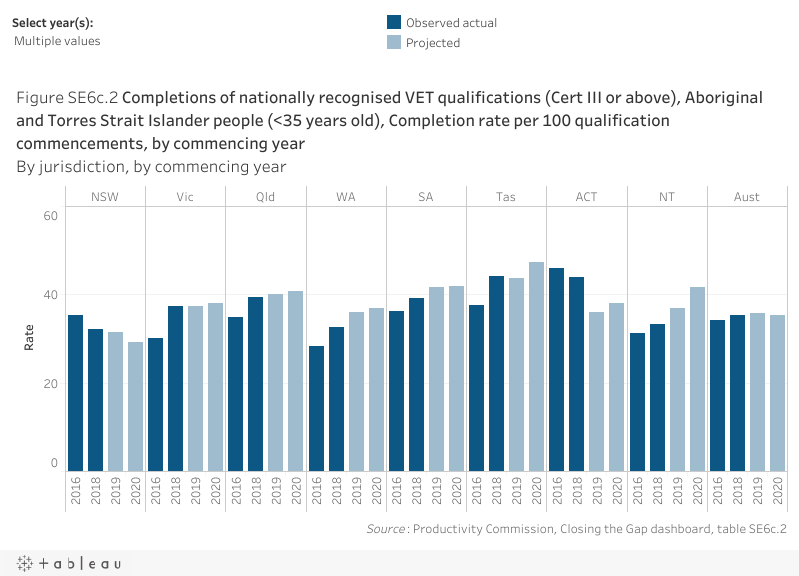Driver
Cert III and above VET commencements, attrition and completion rates
Data tables appear under figures
Measure 1
Number of qualifications (Australian Qualifications Framework (AQF) Certificate level III or above) commenced by students aged 34 years or under
Nationally in 2022, there were 39,495 VET qualifications (Certificate level III or above) commenced by Aboriginal and Torres Strait Islander students aged 34 years or under (figure SE6c.1). This is an increase from the previous year (36,976 commencements) but remains below the 2016 baseline year (39,749 commencements).

Measure 2
Completion rate for nationally recognised VET qualifications (AQF Certificate level III or above) that were commenced by students aged 34 years or under
Nationally, the expected completion rate in 2024 of qualifications (Certificate level III or above) commenced by Aboriginal and Torres Strait Islander students aged 34 years or under in 2020 is 35.4% (figure SE6c.2). This is higher than the completion rate in 2020 of qualifications that were commenced in 2016 (34.1%).

Indicator data specifications
Related outcome: | Aboriginal and Torres Strait Islander students reach their full potential through further education pathways. |
|---|---|
Related target: | By 2031, increase the proportion of Aboriginal and Torres Strait Islander people aged 25–34 years who have completed a tertiary qualification (Certificate level III and above) to 70%. |
Indicator: | Certificate III or above Vocational Education and Training (VET) commencements, attrition and completion rates. |
Measure: | There are two measures for this indicator. Measure 1 is the number of qualifications (Australian Qualifications Framework (AQF) Certificate level III or above) commenced by students aged 34 years or under, defined as: Numerator: Number of qualifications (AQF Certificate level III or above) commenced by Aboriginal and Torres Strait Islander students aged 34 years or under and is presented as a number. Measure 2 is the completion rate for nationally recognised VET qualifications (AQF Certificate level III or above) that were commenced by students aged 34 years or under, defined as: Numerator – number of VET qualifications (AQF Certificate level III or above) completed (observed and projected) by Aboriginal and Torres Strait Islander students (aged 34 years or under at qualification commencement) within four years of the commencing year, by the commencement year Denominator – number of qualifications (AQF Certificate level III or above) commenced by Aboriginal and Torres Strait Islander students aged 34 years or under, by the commencement year and is presented as a rate. |
Indicator established: | National Agreement on Closing the Gap July 2020 |
Latest dashboard update for the indicator: | 6 March 2024 |
Indicator type: | Contextual information |
Interpretation of change: | Measure 1: A high or increasing number is desirable. Measure 2: A high or increasing rate is desirable. |
Data source(s): | Measure 1 Name: Total VET students and courses Frequency: Annual (revised data are included in the March 2023 Dashboard update) Documentation (links): https://www.ncver.edu.au/research-and-statistics/collections/students-and-courses-collection/total-vet-students-and-courses Measure 2 Name: VET qualification completion rates Frequency: Annual (revised data are included in the March 2023 Dashboard update) Documentation (links): https://www.ncver.edu.au/research-and-statistics/collections/students-and-courses-collection/vet-qualification-completion-rates |
Data provider: | Provider name: National Centre for Vocational Education Research (NCVER) |
Baseline year: | Both measures 2016 |
Latest reporting period: | Measure 1 2022 Measure 2 2020 |
Disaggregations: | State and territory and Australia, by Indigenous status. |
Computation: | Measure 1 Numerator. Measure 2 Numerator divided by Denominator multiplied by 100. Counting rules Measures 1 and 2 Indigenous status is determined by whether a student self‑identifies as being of Aboriginal or Torres Strait Islander descent or both. Geographical variables are based on where a student usually resides. Domestic students excludes students whose residence is ‘Offshore’. Australian totals include ‘Not known’ state and territory of residence. Qualifications refer to nationally recognised programs that are associated with one or more clusters of subjects that lead to a level of education recognised under the AQF. Includes (measures 1 and 2): Qualifications at AQF Certificate level III or IV (including Certificate III or IV nfd), Diploma or Advanced Diploma, or Graduate Diploma/Certificate (or above). Measure 1 only Qualification commencements are counted according to the year the program enrolment first appears in the National VET Provider Collection. Measure 2 only A VET qualification completion rate is defined as the proportion of VET qualifications that commenced in a given year that are eventually completed. It requires knowledge about when a student commences a qualification and, ultimately, when a student exits (such as successfully completing or discontinuing). Qualification commencements are counted according to the year the program enrolment first appears in the National VET Provider Collection, adjusted as a part of the process to match students across years. Observed actual completion rates are only reported for qualifications that commenced four years prior to the most recent data collection period, based on the assumption that enough time has passed for all students who were going to complete their qualification to have done so. Projected completion rates are an estimate of the proportion of VET qualifications commenced in a given year that will eventually be completed. Rates for the three most recent years are projected, to account for students taking different lengths of time to complete their qualification. Projected completion rates become more accurate over the three years until they become observed actual rates in the fourth year. |
Data quality considerations: | Projected completion rates, particularly for qualifications commencing in the most recent year, are likely to be overstated due to the high proportion of continuing students in the forecast calculations. As time passes, projections come closer to actuals as more records reach their final state of ‘completed’ or ‘discontinued’. Projected completion rates are only available for commencements up to 2020 as per the method employed by the NCVER. Under the completion rate methodology, counts of qualification commencements and completions are adjusted as a part of a data matching exercise and will not match the total counts available from the NCVER Total VET students and courses. The data for these measures are subject to an annual revisions process. Data may be revised for several reasons (such as to incorporate data submitted to NCVER after the previous reporting window was closed). See https://www.ncver.edu.au/research-and-statistics/collections/students-and-courses-collection/total-vet-students-and-courses As many individuals undertake particular VET subjects with a view to obtaining particular skills rather than obtaining a complete qualification the completion rates may underestimate the skills gained. Care should be taken when considering VET commencement and completion rate data, as these measures do not account for differences in the quality of education and training (whether the education and training meets the needs of students and/or their employers) across students courses within a year or over time. Further explanation of qualification completion rates, including recent methodological reviews can be found in the technical paper VET qualification completion rates: an evaluation of the current method (available at https://www.ncver.edu.au/research-and-statistics/publications/all-publications/vet-qualification-completion-rates-an-evaluation-of-the-current-method). |
Future reporting: | Additional disaggregations require for future reporting:
|
